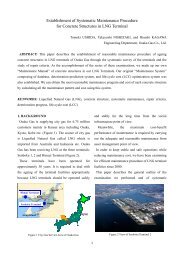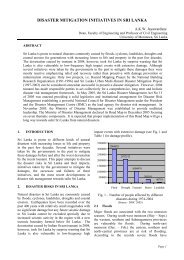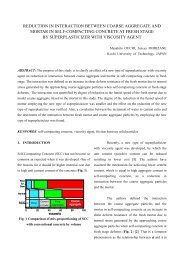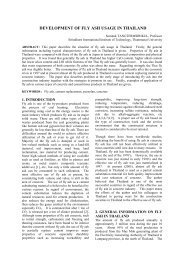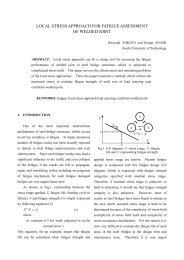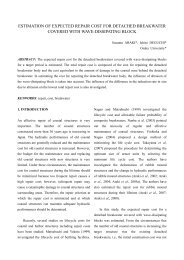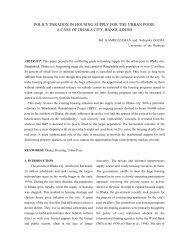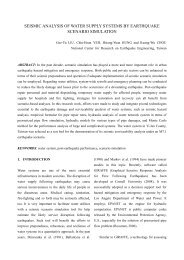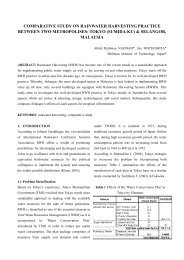Change in Flowability of Self-Compacting Concrete due to Pumping
Change in Flowability of Self-Compacting Concrete due to Pumping
Change in Flowability of Self-Compacting Concrete due to Pumping
Create successful ePaper yourself
Turn your PDF publications into a flip-book with our unique Google optimized e-Paper software.
Table 1 Mix proportions<br />
No.<br />
W/C s/m SP/C Unit weight (kg/m 3 )<br />
(%) (%) (%) Water Cement F<strong>in</strong>e aggregate SP<br />
A-1 28.6 45 0.78 264 922 1224 7.19<br />
A-2 28.6 45 0.85 264 922 1224 8.76<br />
B-1 29.8 45 0.78 269 904 1224 7.05<br />
C-1 27.0 45 0.78 256 947 1224 7.39<br />
Table 2 Materials<br />
Material<br />
Specifications<br />
Low-heat portland<br />
Specify gravity: 3.22<br />
cement<br />
Specify gravity: 2.72;<br />
Crushed sand<br />
FM:3.00<br />
Superplasticizer Polycarboxylate type<br />
2. METHODOLOGY<br />
2.1 Materials and mix proportions<br />
The mix-proportion<strong>in</strong>g <strong>of</strong> the mortar is shown <strong>in</strong><br />
Table 1 and the materials are shown <strong>in</strong> Table 2. The<br />
practical mix-proportion<strong>in</strong>g <strong>of</strong> self-compact<strong>in</strong>g<br />
concrete’s mortar was assumed.<br />
2.2 Apply <strong>of</strong> external force <strong>to</strong> mortar<br />
The pressure <strong>to</strong> the SCC's mortar was 8.8 MPa with the<br />
pressuriz<strong>in</strong>g bleed<strong>in</strong>g vessel <strong>to</strong> generate compressive<br />
stress <strong>in</strong> the mortar. Also, re-mix<strong>in</strong>g speed was 125<br />
rpm on the axis and paddle revolved at 285 rpm <strong>to</strong><br />
generate shear stress <strong>in</strong> the mortar. The duration <strong>of</strong> the<br />
pressure and re-mix<strong>in</strong>g was one, three or five m<strong>in</strong>utes<br />
respectively.<br />
divided <strong>in</strong><strong>to</strong> two portions. One portion was subjected<br />
<strong>to</strong> pressurization test and re-mix<strong>in</strong>g for compressive<br />
and shear stress. Another portion was kept still.<br />
After that, flow and funnel tests were carried out for<br />
each portion <strong>of</strong> the mortar. These tests were carried<br />
out at almost the same time so that the <strong>in</strong>fluence <strong>of</strong><br />
the time may be m<strong>in</strong>imized. And, the flowability <strong>of</strong><br />
the two pars <strong>of</strong> mortar was compared. The <strong>in</strong>fluence<br />
<strong>of</strong> the external force was evaluated by compar<strong>in</strong>g the<br />
two pairs <strong>of</strong> flowability test results.<br />
(1) Deformability Gm and Viscosity Rm<br />
The mortar flow employed the mortar flow corn<br />
(Fig. 2). And the deformability was obta<strong>in</strong>ed with (1).<br />
The discharg<strong>in</strong>g time through funnel was measured<br />
us<strong>in</strong>g the funnel test (Fig. 3). And the <strong>in</strong>dex for the<br />
viscosity was obta<strong>in</strong>ed with (2). The evaluation <strong>of</strong><br />
flowability used two <strong>in</strong>dexes 3) .<br />
70mm<br />
60mm<br />
d 1<br />
d 2<br />
d 0<br />
=100mm<br />
Fig. 2 Mortar flow test<br />
2.3 Test method for flowability <strong>of</strong> mortar<br />
First, mortar was mixed. The mix<strong>in</strong>g speed was 125<br />
rpm on the axis and paddle revolved at 285 rpm.<br />
Next, the mortar was kept still afterwards at up <strong>to</strong> 30<br />
m<strong>in</strong>utes assum<strong>in</strong>g the time between the batch<strong>in</strong>g<br />
plant and the cast<strong>in</strong>g site. After that the mortar was



